
A Partridge (detail) in a bestiary, about 1270. Tempera colors, gold leaf, and ink on parchment, 7 ½ x 5 5/8 in. (19.1 x 14.3 cm). The J. Paul Getty Museum, Ms. Ludwig XV 3, fol. 38v
Illuminated manuscripts are one of my true loves, and as a treat for the 12 days of Christmas, I’d like to share just a few of the glorious things that my true love gave to me this year.
On the first day of Christmas, my true love gave to me…
Partridges and Pears!
Partridges, like many of the birds in the well-known Christmas carol “The 12 Days of Christmas,” can be found in a medieval book known as a bestiary. Images and descriptions of real and imaginary animals mingled together in bestiaries, providing the reader with visual delight and moral lessons.
One of the most beloved manuscripts in the Getty’s collection is the Model Book of Calligraphy, in which the artist Joris Hoefnagel painted flowers, fruits, insects, and other creatures with such attention to detail that they appear to grow, live, and breathe on the pages. The pear below, for example, looks almost real enough to eat.
(For those purists who expected an image of birds in a tree, thereby more closely relating to the line “a partridge in a pear tree,” check out this image from another bestiary in the manuscripts collection.)
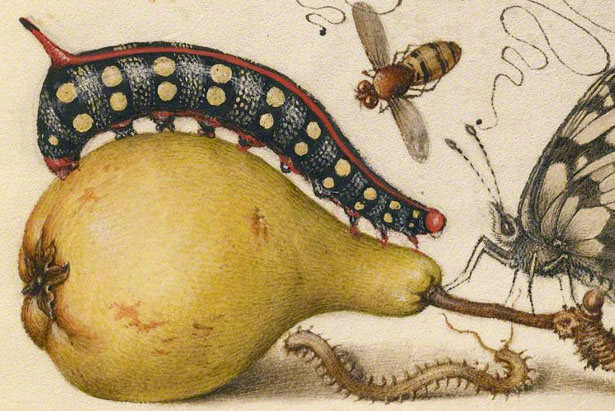
Fly, Caterpillar, Pear, and Centipede (detail), in Model Book of Calligraphy, 1591–96, Joris Hoefnagel. Watercolors, gold and silver paint, and ink on parchment, 6 9/16 x 4 7/8 in. (16.6 x 12.4 cm). The J. Paul Getty Museum, Ms. 20, fol. 7
2 Turtledoves and 3 French Hens

Turtledoves in the Northumberland Bestiary, about 1250–60. Pen-and-ink drawings tinted with body color and translucent washes on parchment, 8 ¼ x 6 3/16 in. (21 x 15.7 cm). The J. Paul Getty Museum, Ms. 100, fol. 44
Turtledoves are, together with swans, some of the most romantic birds—because, according to medieval bestiaries, they take a single lover for life. They are also symbols of moderation.
By contrast, the “French hen,” or cock (rooster), is more of a solitary bird, prone to dueling and asserting its dominance over other creatures. In the miniature below from Jean Froissart’s Chronicles, a group of hens devour pieces of grain. According to Froissart, the Turkish king, shown on the balcony above, threatened to send an army totaling the number of grains in a bag to attack the king of Hungary, to which the latter replied by having starving hens consume the grain, thereby demonstrating his own military might.
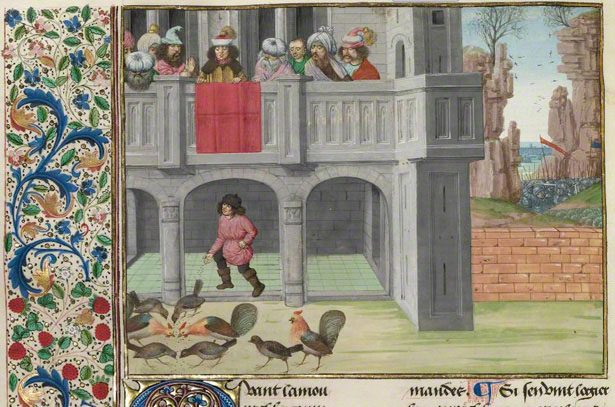
The Parable of the Hens and the Corn, about 1480, Master of the Getty Froissart. Tempera colors, gold leaf, gold paint, and ink on parchment, 18 7/8 x 13 ¾ in. (48 x 35 cm). The J. Paul Getty Museum, Ms. Ludwig XIII 7, fol. 83v
4 Colly Birds?
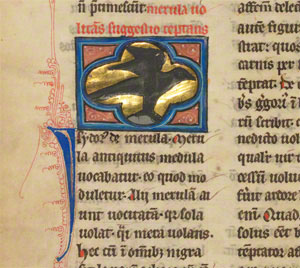
A Blackbird, (detail), fourth quarter of the 13th century (after 1277). Tempera colors, pen and ink, gold leaf, and gold paint on parchment, 9 3/16 x 6 7/16 in. (23.3 x 16.4 cm). The J. Paul Getty Museum, Ms. Ludwig XV 4, fol. 40v
If you’re like me, you probably sing the fourth verse of “The 12 Days of Christmas” with the words, “four calling birds…” Evidently, the earliest versions of the song say, “four colly birds,” which is another way to say blackbirds.
To be true to the song, here’s a lovely blackbird from a bestiary, but since I prefer “calling birds,” I’ve also selected an illumination showing Christ creating lots of birds from another bestiary in the collection.
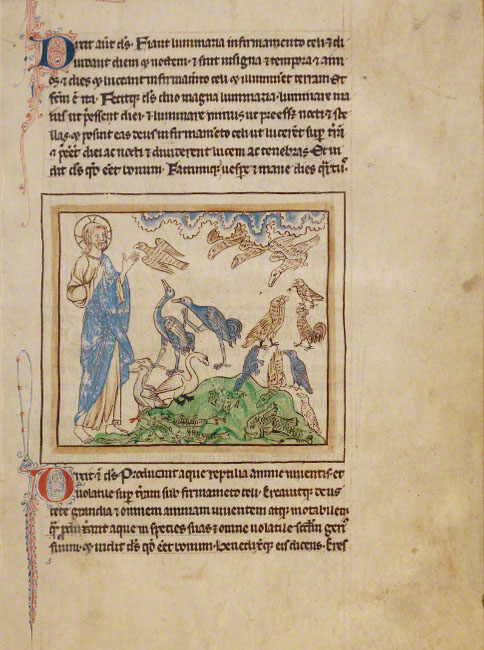
The Creation of the Birds and Fishes in the Northumberland Bestiary, about 1250–60. Pen-and-ink drawings tinted with body color and translucent washes on parchment, 8 ¼ x 6 3/16 in. (21 x 15.7 cm). The J. Paul Getty Museum, Ms. 100, fol. 3
5 Golden Rings
Finding golden rings in illuminated manuscripts required the skill of Bilbo Baggins from The Hobbit. I chose five historiated initial Os from the multi-volume Marquette Bible because the scenes taking place within the round form of the “O” are set against a brilliant gold background. (Evidently “golden ring” can also refer to a pheasant because of the golden ring of feathers on its neck, but we’ve already seen plenty of birds and will still encounter two more before the song is over.)
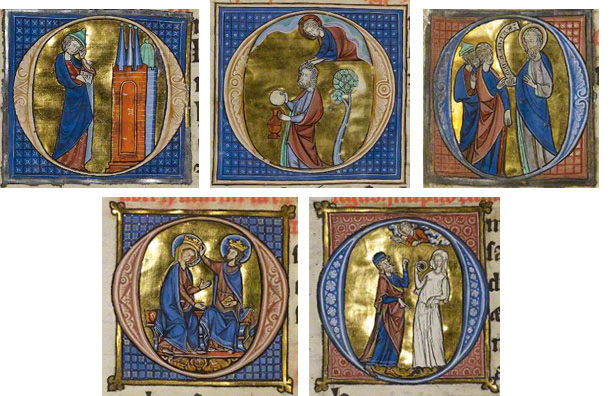
Clockwise from top left: Initial O: Nahum Lamenting the Fall of Nineveh from the Marquette Bible, vol. 2, folio 185v; Initial O: Habakkuk with Food from God from the Marquette Bible, vol. 2, folio 186v; Initial O: Malachi Speaking to the Israelites from the Marquette Bible, vol. 2, folio 201; Initial O: Malachi Speaking to the Israelites from Marquette Bible, vol. 3, folio 221v; Initial O: A Prophet Instructing a Woman with a Mirror from the Marquette Bible, vol. 3, folio 234. All made about 1270. Tempera colors, black ink, and gold leaf on parchment. The J. Paul Getty Museum, Ms. Ludwig I 8
6 Geese Not-So-Much A-Laying
One of the great and ambitious literary undertakings of the Middle Ages was Vincent de Beauvais’s The Mirror of History, a text that endeavored to cover all history from the Creation until the author’s own lifetime around 1254. One event recounts that after the Trojan War, the companions of a Greek hero named Diomedes offended the goddess Venus and she, in turn, transformed them into a flock of geese (or herons or other large birds, depending on the translation). Vincent de Beauvais describes the bird-men as quite violent, which is perhaps why they are often thought to have been transformed into geese, since geese attack when provoked. In the illumination below at left, you can see that these “geese” are certainly not in the process of laying eggs. The goose in the bestiary (below at right) looks much more gooselike than those in The Mirror of History.
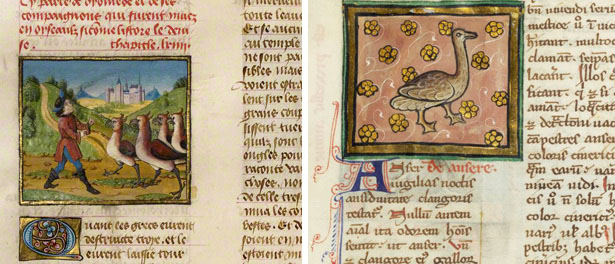
Left: The Companions of Diomedes Changed to Geese in The Mirror of History, about 1475. Tempera colors, gold leaf, and gold paint on parchment, 17 ¼ x 12 in. (43.8 x 30.5 cm). The J. Paul Getty Museum, Ms. Ludwig XIII 5, v1, fol. 116v. Right: A Goose in a bestiary, about 1270. Tempera colors, gold leaf, and ink on parchment, 7 ½ x 5 5/8 in. (19.1 x 14.3 cm). The J. Paul Getty Museum, Ms. Ludwig XV 3, fol. 36
7 Swans-a-Swimming
One of my personal favorites in the Getty’s manuscript collection is the Prayer Book of Cardinal Albrecht of Brandenburg, illuminated by Simon Bening. In the lower right corner of a border showing the creation of the fish and birds, Bening delicately painted two swans swimming peacefully along, undisturbed by the frightening-looking fish nearby.
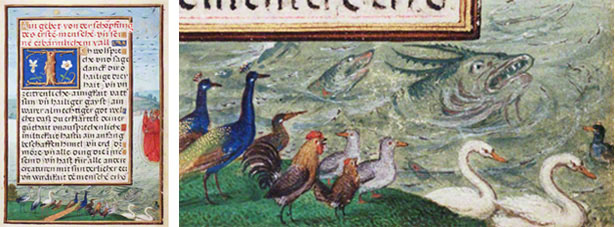
Border with the Creation of Birds and Fishes from the Prayer Book of Cardinal Albrecht of Brandenburg, about 1525–30, Simon Bening. Tempera colors, gold paint, and gold leaf on parchment, 6 5/8 x 4 ½ in. (16.8 x 11.4 cm). The J. Paul Getty Museum, Ms. Ludwig IX 19, fol. 8
8 Maids-a-Milking
The Spinola Hours is one of the most visually ambitious Flemish manuscripts of the 16th century. Like many books of hours, the Spinola Hours opens with a calendar of church holidays, and these pages are illuminated with an activity associated with the month. For April, a woman milks a cow in a farmyard.
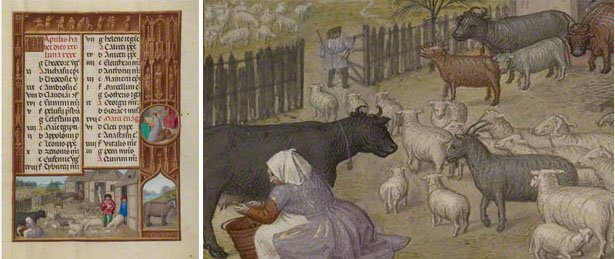
Farm Animals, Milking, and Buttermaking; Zodiacal Sign of Taurus from the Spinola Hours, about 1510–20, Workshop of the Master of James IV of Scotland. Tempera color, gold, and ink on parchment, 9 1/8 x 6 9/16 in. (23.2 x 16.7 cm). The J. Paul Getty Museum, Ms. Ludwig IX 18, fol. 3
9 Drummers Drumming
Amidst the fanciful foliage in the borders of two pages from another book of hours, we encounter a man and an angel beating drums. These marginalia enliven the pages and respond to the central miniatures by creating a melodious symphony.

Left: The Nativity in a book of hours, folio 84. Right: The Virgin and Child Enthroned in a book of hours, folio 33v. Both about 1420, Spitz Master. Tempera colors, gold, and ink on parchment, 7 15/16 x 5 7/8 in. (20.2 x 14.9 cm). The J. Paul Getty Museum, Ms. 57
10 Ladies Dancing
The Romance of the Rose is one of the great chivalric poems of the Middle Ages. The tale recounts how a Lover, in a dream, pursues the fairest Rose, which represents his beloved. In the illumination below, several ladies are led in dance by the winged God of Love.
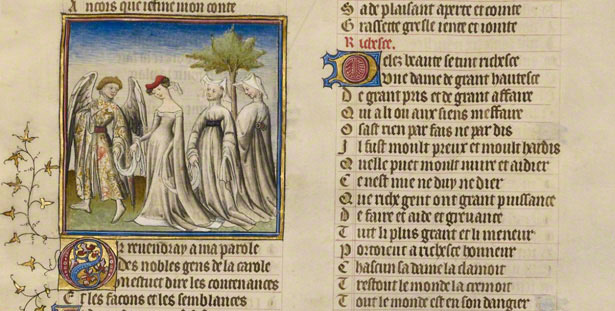
The God of Love Dancing in Romance of the Rose, about 1405. Tempera colors, gold leaf, and ink on parchment, 14 7/16 x 10 ¼ in. (36.7 x 26 cm). The J. Paul Getty Museum, Ms. Ludwig XV 7, fol. 8
11 Pipers Piping
Similar to the drummers mentioned above, a piper plays a bagpipe in the margins of the Prayer Book of Charles the Bold. Did you happen to notice that in the previous image from a book of hours both the man and the angel also play a flute? These marginalia are full of talented multitasking musicians!
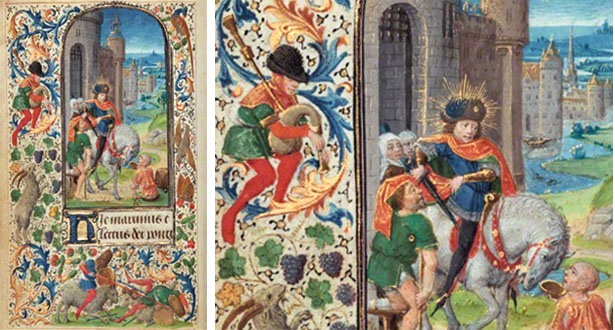
Saint Martin Dividing His Cloak, 1469, Lieven van Lathem. Tempera colors, gold leaf, gold paint, silver paint, and ink on parchment, 4 7/8 x 3 5/8 in. (12.4 x 9.2 cm). The J. Paul Getty Museum, Ms. 37, fol. 34v
12 Lords-a-Leaping
Many associate the Middle Ages with chivalry and knights in armor, damsels in distress, castles, and dragons. All of these are seen in our final illumination, also from a book of hours, in which Saint George and his horse leap toward a ferocious dragon in order to save a fair maiden.
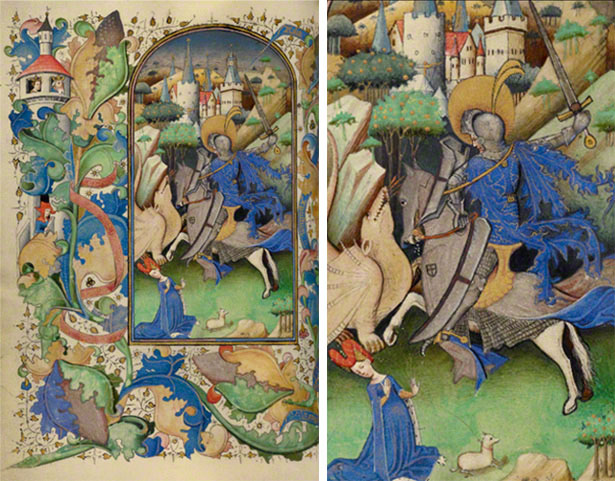
Saint George and the Dragon from a book of hours, about 1450–55, Master of Guillebert de Mets. Tempera colors, gold leaf, and ink on parchment, 7 5/8 x. 5 ½ in. (19.4 x 14 cm). The J. Paul Getty Museum, Ms. 2, fol. 18v
The 12 days of Christmas begin on Christmas day and end on the evening before the feast of epiphany (January 6), which commemorates the magi and the gifts they share with the Christ child. Merry Christmas!

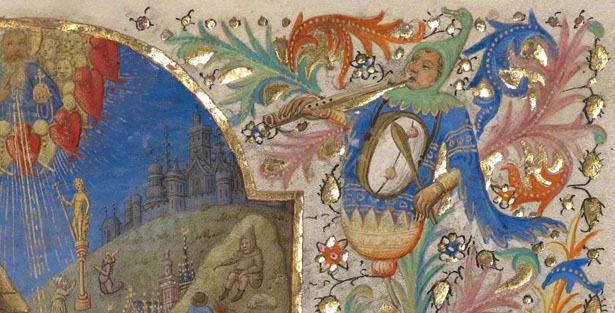
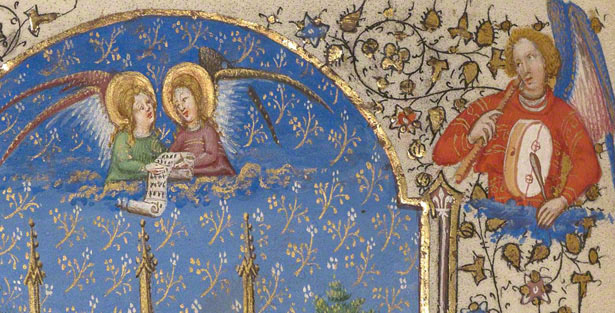

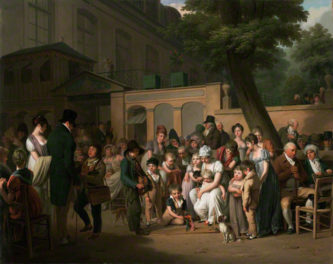
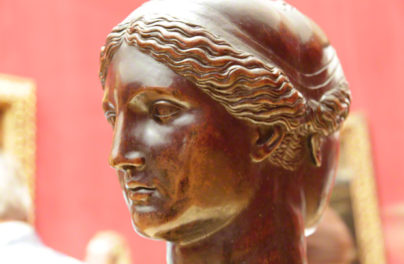
Amazing! Thanks Prof. Keene. Marvelously written.
I notice you quoted the song as “my true love gave to me”. I agree it should be gave but others tell me it is “sent to me”. Can you settle the argument?